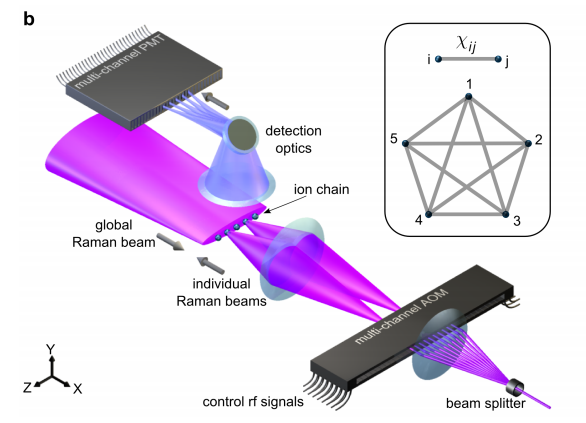The Long-Awaited Promise of a Programmable Quantum Computer
The quest to build a powerful quantum computer is one of the great challenges of 21st century physics. And although the hurdles are significant, physicists are chasing them down, one by one.
They’ve gradually learned how to control quantum particles with the precision necessary to run quantum algorithms on a small scale with just a few qubits.
The big challenge now is scale—combining these techniques in a way that can handle large numbers of qubits and perform powerful quantum calculations. Today, Shantanu Debnath and pals at the University of Maryland in College Park unveil a five-qubit quantum computer module that can be programmed to run any quantum algorithm.
But crucially, they say, this module can be linked to others to perform powerful quantum computations involving large numbers of qubits. “This small quantum computer can be scaled to larger numbers of qubits within a single module, and can be further expanded by connecting many modules,” say Debnath and co.
Physicists have been able to run quantum algorithms on quantum computers for almost 20 years—the first two- and three-qubit machines began number crunching in the late 1990s. But since then, progress has stalled because of the extreme difficulty in linking together large numbers of quantum particles while maintaining their quantum states.
(This discounts the controversial work of the Canadian company D-Wave, which claims to have built a quantum computer capable of handling over 1,000 qubits. Most quantum physicists are deeply skeptical of these claims.)

The new device builds on the considerable work over the last two decades on trapped ion quantum computers. It consists of five ytterbium ions lined up and trapped in an electromagnetic field. The electronic state of each ion can be controlled by zapping it with a laser. This allows each ion to store a bit of quantum information.
Because they are charged, the ions exert a force on each other, and this causes them to vibrate at frequencies that can be precisely controlled and manipulated. These vibrations are quantum in nature and allow the ions to become entangled. In this way, the quantum bits they hold can interact.
By controlling these interactions, physicists can carry out quantum logic operations. And quantum algorithms are simply a series of these logic operations one after the other.
The ability to perform an arbitrary series of operations is important—few quantum computers are capable of doing this. Indeed, most have been designed to perform a specific single quantum algorithm.
That’s what Debnath and co have set out to change. The researchers have built a self-contained module capable of addressing each of the ions with a laser and reading out the results of the interaction between qubits.
And it appears to work well. The team has put the device through its paces by implementing several different quantum algorithms: “As examples, we implement the Deutsch-Jozsa, Bernstein-Vazirani, and quantum Fourier transform algorithms,” they say. “The algorithms presented here illustrate the computational flexibility provided by the ion trap quantum architecture.”
That’s certainly impressive but the team claims it can go much further. In particular, they say that their module is scalable—that several five-qubit modules can be connected together to form a much more powerful quantum computer.
But that’s easier said than done, and the team has not yet demonstrated this. So the next step is obvious. What Debnath and co need to do next is show how to connect these modules and how this increases the utility of the computations that are possible.
That would be a big step and one that would be worth shouting from the rooftops about—if they achieve it.
Ref: arxiv.org/abs/1603.04512 : Demonstration of a Programmable Quantum Computer Module
Keep Reading
Most Popular
Large language models can do jaw-dropping things. But nobody knows exactly why.
And that's a problem. Figuring it out is one of the biggest scientific puzzles of our time and a crucial step towards controlling more powerful future models.
How scientists traced a mysterious covid case back to six toilets
When wastewater surveillance turns into a hunt for a single infected individual, the ethics get tricky.
The problem with plug-in hybrids? Their drivers.
Plug-in hybrids are often sold as a transition to EVs, but new data from Europe shows we’re still underestimating the emissions they produce.
Stay connected
Get the latest updates from
MIT Technology Review
Discover special offers, top stories, upcoming events, and more.